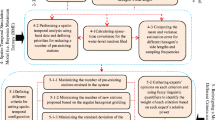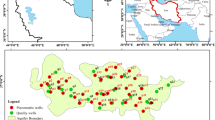Abstract
Groundwater resource management and planning requires appropriate and accurate data. These data, which can be collected by monitoring networks, may contain too little, enough or redundant information. This study aims to evaluate the monitoring cycle in the Gaza Strip (a developing region) using the entropy theory. The approach employed in this study involves gathering data needs for groundwater resource management and planning in the Gaza Strip) through a questionnaire (survey). The questionnaire outlined the groundwater management and planning objectives, tasks and the data which had to be collected through monitoring activities in the Gaza Strip (monitoring cycle). This article also proposes a flowchart, which is used to evaluate the relation between the objectives, the tasks, the data and the monitoring activities using the entropy theory. The evaluation affirms the informativeness of the collected data when they contain enough, too little or redundant information. From this study it can be concluded that in the Gaza Strip the institutional set-up of the water sector needs to be strengthened, and more data should be collected and the existing monitoring networks should be redesigned for the informativeness of the data.
Similar content being viewed by others
References
Chilton, P. J. and Foster, S. S. D., 1996, ‘Monitoring for groundwater quality assessment: Current constraints and future strategies’, in J. J. Ottens, F. A. M. Claessen, P. G. Stoks, J. G. Timmerman and R. C. Ward (eds.), Monitoring Tailor-made II, Elsevier Science B.V., The Netherlands, pp. 53–63.
Harmancioglu, N. B. and Alpaslan N. S. D., 1992, ‘Water quality monitoring network design’, Water Res. Bull. 28(1), 179–192.
Harmancioglu, N. B., Fistikoglu, O., Ozkul, S. D., Singh, V. P., and Alpaslan, N., 1999, Water Quality Monitoring Network Design, Kluwer Academic Publishers, Boston, 290 pp.
Harmancioglu, N. B., Ozkul, O., Alpaslan, N. S. D. and, Singh, V. P., 1996, Integrated Approach to Environmental Data Management Systems, Kluwer Academic Publishers, Boston, 550 pp.
Husain, T., 1989, ‘Hydrologic uncertainty measure and network design’, Water Res. Bull. 25(3), 527–534.
Jedlitschka, J., 1997, ‘Groundwater monitoring in Germany’, in J. J. Ottens, F. A. M. Claessen, P. G. Stoks, J. G. Timmerman and R. C. Ward (eds.), Monitoring Tailor-made II, Elsevier Science B.V., The Netherlands, pp. 65–74.
Lyonnaise des Eaux & Khatib and Alami (LEKA), 1999, Service Improvement Project and Wastewater Systems in the Gaza Strip, Technical Report, Gaza, Palestine.
Metcalf & Eddy, 2000a, The Gaza Costal Aquifer Management Program, Integrated Aquifer Management Plan-Task 3, Vol. 1. The program is funded by US Agency for International Development (USAID) and owned by the Palestinian Water Authority (PWA), Gaza, Palestine.
Metcalf & Eddy, 2000b, Aquifer Monitoring Plan-Task 7. The program is funded by US Agency for International Development (USAID) and owned by the Palestinian Water Authority (PWA), Gaza, Palestine.
Mogheir, Y., 2003, Assessment and Redesign of Groundwater Quality Monitoring Networks Using the Entropy Theory – Gaza Strip Case Study. Ph.D. Thesis, University of Coimbra, Coimbra, Portugal, 319 pp.
Mogheir, Y. and Singh, V. P., 2002, ‘Application of information theory to groundwater quality monitoring networks’, Water Res. Manag. 16(1), 37–49.
Mogheir, Y., de Lima, J. L. M. P., and Singh V. P., 2003a, ‘Applying the entropy theory for describing the spatial structure of groundwater regionalized variables (EC and Chloride)’, in M. V. Neves and A. C. V. Neves (eds.), Environment 2010: Situation and Perspectives for the European Union, University of Porto, Portugal, paper G 01.
Mogheir, Y, Singh, V. P., and de Lima J. L. M. P., 2003b, ‘Redesigning the Gaza Strip groundwater quality monitoring network using entropy’, in V. P. Singh and R. Y. Yadava (eds.), Water and Environment: Groundwater Pollution, Allied Publishers, New Delhi, India, Vol. 5, pp. 315–331.
Palestinian Water Authority (PWA), 1999, ‘Water Sector Planning Study (WSSPS)’, Final Report, Carl Bro International for Palestinian Economic Council for development and Reconstruction, and the World Bank. Gaza, Palestine.
Palestinian Water Authority (PWA), 2000, ‘National Water Plan’, Final Report, The study is funded by United Nation Development Program (UNDP) and owned by the Palestinian Water Authority (PWA). Gaza, Palestine.
Ward, R. C., Loftis, J. C., and McBride, G. B., 1986, ‘The data-rich but information-poor syndrome in water quality monitoring’, Environ. Manag. 10, 291–297.
Whitfield, P. H., 1988, ‘Goals and data collection design for water quality monitoring’, Water Res. Bull. 24, 775–780.
World Meteorological Organization (WMO), 1990, Cost-Benefit Assessment Techniques and User Requirements for Hydrological Data, Operational Hydrology Report No. 32, WMO-No.717. Geneva, Switzerland.
Yang, Y. and Burn, D., 1994, ‘An entropy approach to data collection network design’, J. Hydrol. 157, 307–324.
Author information
Authors and Affiliations
Corresponding author
Rights and permissions
About this article
Cite this article
Mogheir, Y., De Lima, J.L.M.P. & Singh, V.P. Assessment of Informativeness of Groundwater Monitoring in Developing Regions (Gaza Strip Case Study). Water Resour Manage 19, 737–757 (2005). https://doi.org/10.1007/s11269-005-6107-6
Received:
Accepted:
Issue Date:
DOI: https://doi.org/10.1007/s11269-005-6107-6




